You now need to work through the following steps to ensure that Bill is suitable for a gastrostomy.
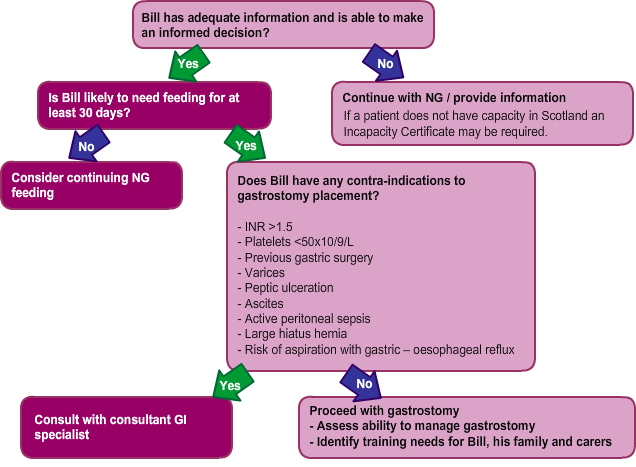
Bill has capacity and has consented to gastrostomy tube placement.
You now need to work through the following steps to ensure that Bill is suitable for a gastrostomy.

Bill has capacity and has consented to gastrostomy tube placement.
Bill and his family want to discuss some of the things they have heard about gastrostomy tubes which worry them. Identify the myths below:
Bill and his family are now reassured about the procedure of gastrostomy.
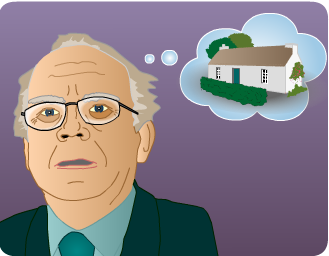
Bill has had his NG tube in place for 4 weeks and has been working with the speech and language therapist regularly regarding his swallow. As yet, his swallow remains severely impaired and Bill is not having anything to eat or drink orally.
Bill is progressing with physiotherapy and is keen to go home.
One of the main considerations for Bill going home is how Bill will meet his nutrition and hydration needs in the longer term, if his swallow remains impaired.
In particular, the consideration of a more permanent tube eg. gastrostomy (PEG/RIG) is being discussed with Bill and his family. Dietetics are also involved in his care at this stage, and are discussing options for feeding regimen with Bill.
Bill complains of too much saliva in his mouth making him drool and is embarrassed by this.
You have now covered the issues around Bill’s early care – now you need to consider the longer-term aspects of his care.

| Action | Comments |
|---|---|
| Clean Bill’s denture plate over a basin of cold water | This is in case you drop it whilst cleaning and it breaks |
| Brush the denture with unperfumed soap or toothpaste to remove build up of saliva and/or food if person is eating and drinking | Overuse of denture cleaner with bleach can discolour dentures |
| If Bill prefers, remove his denture plate and store overnight in cold water | Label the container as Bill doesn’t want to lose his teeth to someone else |
 Issue: Bill has his own natural teeth and also a partial top plate, so how should I carry out oral hygiene?
Issue: Bill has his own natural teeth and also a partial top plate, so how should I carry out oral hygiene?
Action/Rationale: Follow the following 6 steps to assist Bill with his oral hygiene.
| Action | Comments |
|---|---|
| 1) Assist Bill to get into an appropriate position to avoid choking/aspiration during mouth care | Sitting upright or lying on one side with head turned to the dependent side is best. |
| 2) Prepare materials, protect clothing, assist Bill to lubricate his lips. Ask Bill to remove or assist Bill to remove his denture plate | Be prepared before you commence mouth care and remember to wear gloves to protect yourself and Bill from cross-infection. |
| 3) Retract Bill’s lips/tongue with gauze. Brush all surfaces of the teeth with sulphate free fluoride toothpaste or chlorhexidine gel. Gently brush soft tissues and palate |
Assist Bill to reach all areas. A toothbrush is better than a foam swab at removing plaque. Remind Bill not to use toothpaste/ chlorhexidine gel together as this decreases their effectiveness. |
| 4) Rinse Bill’s mouth with water either by using a cup if he has good oral control or by using a 10ml syringe then aspirate the fluid with a yanker suction catheter | Ask Bill to wipe his mouth with a tissue at the end to get rid of any residual toothpaste or fluids. |
| 5) Assist Bill to lubricate his lips with appropriate material eg. petroleum jelly | This will stop Bill’s lips becoming cracked/sore and uncomfortable |
| 6) Continue to provide and encourage oral care at least 3 x daily | This will maintain optimum health of Bill’s mouth |
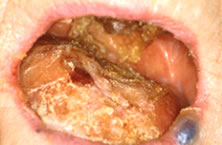
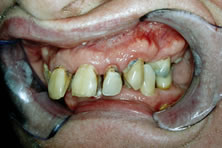
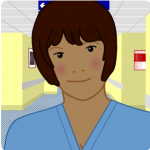
The nurse says:
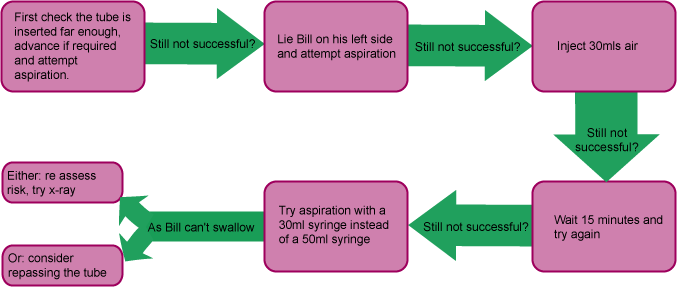
For further information view a local guideline based on the NPSA model (Confirming the correct position of Nasogastric Tubes in adults [PDF 26KB]).
Prior to using a nasogastric tube (NG) it is essential to check that it is in the correct position and that the tube has not moved or become displaced. This can happen easily and the tube position should be checked regularly and prior to administration of anything. Ensure a referral has been made to the dietitian for prescription of a suitable feeding regimen.
Once tube position has been confirmed feeding can be commenced as per Dietetic regimen or out of hours protocol.
NB: Be aware that certain medications can inhibit or reduce gastric aspirate production e.g. Omeprazole, Lansoprazole.
VIDEO: Nasogastric tube misplacement: NHS improvement -continuing risk of death and severe harm
NHS ARTICLE: Patient safety alert: Nasogastric tube misplacement: continuing risk of death and severe harm